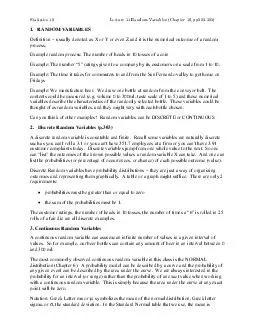

RANDOM VARIABLES Definition usually denoted as X or Y or even Z and it is th e numerical outcome of a random process Example random process The number of heads in 10 tosses of a coin Example The number 5 rating ID: 75675
Download Pdf The PPT/PDF document "RANDOM VARIABLES Definition usually den..." is the property of its rightful owner. Permission is granted to download and print the materials on this web site for personal, non-commercial use only, and to display it on your personal computer provided you do not modify the materials and that you retain all copyright notices contained in the materials. By downloading content from our website, you accept the terms of this agreement.
Statistics 10 Lecture 11 Random Variables (Chapter 16, pp303-305) 1. RANDOM VARIABLES e numerical outcome of a random Example random process: The number of heads in 10 tosses of a coin Example: The number 5 ratings given to a company by its customers on a scale from 1 to 10. Example: The time it takes for commuters to and from the San Fernando valley to get home on Example: We manufacture beer. We draw one bottle at random from the conveyor belt. The contents could be measured (e.g. volume 0 to 300ml, taste scale of 1 to 5) and these numerical variables describe the characteristics of the randomly selected bottle. Thesthought of as random variables, and they might vary with each bottle chosen. Can you think of other examples? Random va2. Discrete Random Variables (p.303) A discrete random variable is countable and finite. Recall some variables are naturally discrete such as you can't roll a 3.1 or you can't have 351.7 employees at a firm or you can't have 3.91 customer complaints today. Discrete variables jump from one whole value to the next. So one can "list" the outcomes of the known possible values a random variable X can take. And one can list the probabilities (or percentage of occurrences, or chance) of each possible outcome (value). Discrete Random variables have probability distoutcomes and representing them graphically. A table or a graph might suffice. There are only 2 requirements: probabilities must be greatethe sum of the probabilities must be 1. The customer ratings, the number ofA continuous random variable can assume an infinite number of values in a given interval of values. So for example, our beer bottles can contain any amount of beer in an interval between 0 and 300 ml. The most commonly observed continuous random A probability model can be describeany given event can be described by the area under the curve. We are always interested in the probability for an interval (or range) rather than the probability of an exact value when working with a continuous random variable. This is simply because the area under the curve at any exact Notation: Greek Letter mu or symbolizes the mean of the normal distribution, Greek letter sigma, or Normal table that we use, the mean is Statistics 10 Lecture 11 Random Variables (Chapter 16, pp303-305) =1. Example: Suppose an automobile manufacturer claims their new SUV has mean in-city mileage of 16 miles per gallon. Suppose you write to the madeviation around that mean is 2 miles per gallon. This information allows you to formulate a probability model. So you think that the random variable "in city gas mileage" can be approximated by a normal distribution with a meanExample: Suppose you work for a magazine that testyou purchased averages less than 13 miles to the gallon? What is the probability that you would purchase one that gets more than 20 miles? Suppose you were to purchase one that gets better than 20 miles per gallon, is your probability model necessarily wrong? Example: Suppose you are thinking about investing some money in a mutual fund. Past data shows that the fund returned a mean of 19.8% wknow it is normally distributed. Based on this information, what is the probability that you will (a loss). What is the probabilitylower? Is the model necessarily wrong? 4. Random Variables have means too The mean of a list of numbers like 1, 2, 3, 4, 5 or like 1,1,2,2,3,3,4,4,5,5, gives every value in the list equal weight. The mean of a random variable is also an average, but probabilities to the outcomes (values the variable can take) and these outcomes do not need to be equal. The examples in part 3 above give a mean (and standard deviation) for a random Generally, the mean of random variables are written µ pronounced "mu sub x" to represent the mean of any random variable x, not just normal ones. What would the symbol µ y mean to you? Another way it mightExample: Suppose it is known that a salesman typically makes 3 phone calls a year to each home in his region and that his chance of making 3 sales (one fo50% or .50). If he earns $200 per sale, how much can he EXPECT to earn in a year (or what would the MEAN of this random variable be)? ble outcomes, but what is "most likely to happen?" or what is EXPECTED to happen?